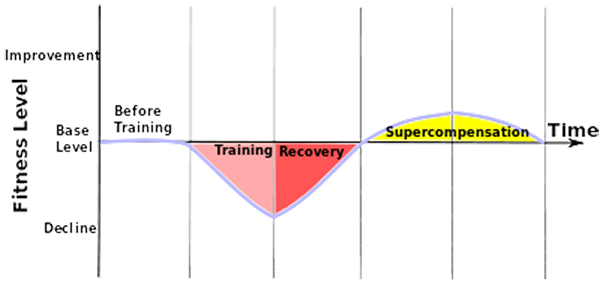
Periodisation Fundamentals
Strength training is an art form. It’s a beautiful combination of problem solving, mathematical equations, brute power and patience. Getting stronger is not simply a case of lift more each week and try harder, you must follow certain principles that allow for long term adaptations.
Here are my top 4 rules of periodisation and how to structure your workouts. Part 1 will cover the basics behind numbers and parameter selection. Part 2 will be more in the trenches experience of how to apply the theory.
1. Volume Vs Intensity
The very basics of periodisation states that each training session must have specific purpose in what you want to achieve. Achievements are quantified by whether you have stimulated the body with a certain amount of volume (amount of reps and sets done) or intensity (the highest amount of
weight lifted). These two aspects lie on a continuum. You would not exclusively do a volume session then intensity session, but rather gently progress from one stimulus to the next by making minor changes each week.
High volume blocks are generally applied to stimulate a hypertrophic response. The body must adapt to the tremendous amount of work it has been put through and so tells the muscles, tendons and ligaments to grow so they can cope with the demands if they are exposed to it again. This only happens if nutrition, recovery and energy intake is sufficient.
Higher intensity blocks cause more neural adaptations. This means the central nervous system adapts by recruiting more muscle fibres and so therefore making a movement pattern or neurological pathway stronger. Neural strength is why you will see 65kg Chinese weight lifters front squat x4 body weight for reps. Their nervous system is incredibly efficient due to the exposure to the stimulus, i.e. lots of practice.
Exposing the body to both these stimuli at the same time is extremely taxing on the body. In any programme, it is incredibly rare to see both the volume and intensity increase linearly UNLESS it is with a complete beginner who started at a very modest level. When it comes to strength training,
as intensity is increased, volume should decrease. So for example:
Week 1: 3 x 8 @ 70% (24 reps)
Week 2: 3 x 6 @ 75% (18 reps)
Week 3: 2 x 5 @ 80% (10 reps)
Week 4: 2 x 3 @ 85% (6 reps)
Starting with 70% is always advisable. It means you will be able to perform adequate volume with perfect form. I once had the pleasure of interviewing powerlifting legend Dave Tate. He explained a workout where you perform 20 reps and only 8 are done with good technique is a counter
productive workout. Lower intensities are essential as building blocks for muscle and form as you progress to heavier loads in the programme.
2. Rep ranges must reflect intensities
So we’ve established that there is a relationship between volume and intensity and that it must be altered in a linear, inversely proportional manner. We now need to decipher what parameters to use (reps & sets) based on your chosen intensity. Now there is no set in stone rule here. Yes, you
must follow guidelines, but intensities are not always what they seem and perceived exertion on the day can have a huge impact on your weight selection. This auto-regulation will be covered in part 2.
Hypertrophic rep ranges (8-12 reps) are performed around 60-70% 1 rep max. As intensity increases, rep selection tends to do so by 1-2 reps. You may be familiar with rep maxes, these are a very useful way of determining gains in strength without having to test your true 1RM. So for example, if your 1 rep max equates to 100% intensity, you should be able to get 3 reps with 90% of this weight and 5 reps with 85% of this weight. This however, is person dependant and can fluctuate given genetics, training history and personality type.
Why is this useful? Well if 90% is our 3 rep max we can expose ourselves to high intensities and moderate volumes by performing reps at circa 10% low than our rep maxes. E.g. 5 sets of 3 at 80% intensity. Here is a simple example of how you can use progressive overload and a smart starting point to improve your 3RM over a 12 week period.
Movement: Bench Press
3RM: 100kg (90%)
Time Scale: 12 weeks
Week 1: 5 x 3 @ 80% = 80kg (follow basic linear periodisation model)
Week 2: 4 x 3 @ 82.5% = 82.5kg
Week 3: 3 x 3 @ 85% = 85kg
Week 4: 2 x 1 @ 90% = 90kg (Deload)
Restart cycle but 2.5kg heavier.
Week 5: 5 x 3 @ 82.5% = 82.5kg (follow basic linear periodisation model)
Week 6: 4 x 3 @ 85% = 85kg
Week 7: 3 x 3 @ 87.5% = 87.5kg
Week 8: 2 x 1 @ 92.5% = 92.5kg (Deload)
Repeat again.
Week 9: 5 x 3 @ 85% = 85kg (follow basic linear periodisation model)
Week 10: 4 x 3 @ 87.5% = 87.5kg
Week 11: 3 x 3 @ 90% = 90kg
Week 12: 1 x 3 @ 92.5-95% = 92.5-95kg
Over time, there has never been more than a 2.5kg increase in bar weight each week. However, through using volume and a smart starting point given the quality you’d like to improve (3RM), you can gradually work up to adding 2.5-5kg to the lift whilst maintaining perfect form. You can use the
exact same principle to improve your 5RM or any other rep range you desire. You just need to start at the right intensity (around 10-15% below RM) and patiently build up.
Part 2
The second instalment of this periodisation fundamentals article is less theory and more experience in application. It’s easy to make linear progression on paper, however experience has taught me that there are certain considerations that must be made when following a strength programme. The following tips are to help you avoid stagnation but also how to recognise when your body is lying to you.
3. Progressive Overload isn’t always the way forward
Load is king. This is a term you’ll hear time and time again in the strength game. I’d never argue that adding weight to the bar doesn’t make you strong but this notion can be abused. Say you can deadlift 200kg for 1 rep. Next week I’m going to ask you to deadlift 201kg for 1 rep. This is a seemingly straight forward task, after all, it’s only a 0.5% increase in weight. Even if you achieve this feat it will eventually reach a point of diminishing returns. If this was not the case, we could all adopt this method to put 50kg on our lifts per year!
The problem with progressive overload is that it can come at the expense of form. A good strength programme doesn’t necessarily have to add more weight to the bar. A sign of good programming is when weights that were previously perceived as heavy feel lighter. That means you don’t always have to add weight to the bar.
So why is this useful? Well, as intensities rise so will the risk of injury. This sounds rather negative I know but handling weights we’ve never used before can be extremely stressful to the body. How many people do you know have hurt themselves from going too heavy? If you’re in a performance based job, such as sport or stunt doubling, attempting to hit a new deadlift 3RM mid season or shoot isn’t advisable. Instead, you could use volume as an overload method, not weight. Here’s an example that I find is excellent for both hypertrophy and conditioning.
Escalating Density 5’s
Escalating Density is when you do more work, week by week in a set period of time. Let’s look at a scenario where this may be ideal.
Say you work long hours and have an active job. Last week you did deadlifts for 3 sets of 4 at 80%. This week calls for 2 sets of 3 at 85%. The only issue is that whilst warming up with 60kg it feels like your max. Progressive overload is very useful when all variables are under control. These are such things as sleep, diet and stress. When these things are negated, so is your potential to add weight to the bar.
Where ED5’s come in is that they provide a nice mixture between lifting heavy, conditioning and stimulating the body for hypertrophy. The method is very simple. Load up the bar with 70% max weight. Give yourself a set amount of time to perform as many sets of 5 in a certain time frame. All sets must be done with perfect form. Week 1 you may hit 6 sets in 15 minutes. This equates to 1 set taking 30 seconds and your rest period being 2 minutes. The week after you may hit 7 sets. The goal is to overload safely through volume and not weight. After 3 weeks, I would change a variable, e.g. week 4 do sets of 3 @ 80% or sets of 8 @ 60%.
As you can see, periodisation isn’t always the adjustment of weight and reps, it can be the manipulation in rest periods, tempo and even exercise variation, it all depends on your goal.
4. Fatigue will mask strength during accumulation phases
Ok so now we’ll be getting in to some nitty gritty geeky strength stuff. This may not apply to you right now, but it’s good to know either way. Hypertrophy training, or classic bodybuilding type splits are all about consistency with volumes, sets and weight. The athlete is more focused on “the pump” and not adding weight each week. Think of this style of training as the Indy 500. Going round and round on the same track whilst maintaining diametric focus not to go off course. Strength training is like the Monaco Grand Prix. It’s a mixture of twists and turns and knowing when to take your foot off the gas and when to accelerate.
A strength training programme requires you to keep pushing until there is an indication that you are potentially getting to an “overreaching’ phase. Over reaching is when the build up of residual fatigue impairs performance in the format of perceived loss of strength. Despite this seeming like a
bad thing, it’s actually a necessity in getting stronger.

Hypothetically speaking, say you are given £4 when you do a challenging strength training session. The only issue is, it costs £5 every time you train. This puts you in a debt of £1 each session. Over the course of a strenuous 4 week cycle training 3 times per week, your body goes in to debt due to accumulative fatigue. A sign of this is when normally manageable weights start to feel very heavy. Strength training doesn’t make you weaker but fatigue and impaired recovery does. Using our money analogy, you would be £12 in debt after the training block.
Blocks of over reaching are typically followed by periods of de-loading or rest so that the body can adequately recover. During this phase, your body goes in to something called “Supercompensation”. Here the body overly compensates for the fatigue it has been put under and so make itself stronger than the original starting point at the beginning of the block. Think of this as still getting your £4 for training three times per week, but not having to pay the £5 fee each session. If you didn’t train for 2 weeks, not only would you get rid of your debt, you’d be £12 up, i.e. stronger.
So what’s the take away point here? You can get weaker getting stronger. Without understanding the principle it’s easy to become frustrated and start to doubt yourself and your programme. Cast your mind back to the Monaco Grand Prix, getting linearly stronger is about knowing when to put your foot down and when to back off whilst simultaneously keeping track of all variables. Always respect your body and always respect the law of compensation. Fatigue masks strength and true reflexions of the strength built during a phase is shown after a rest or de-load.

















